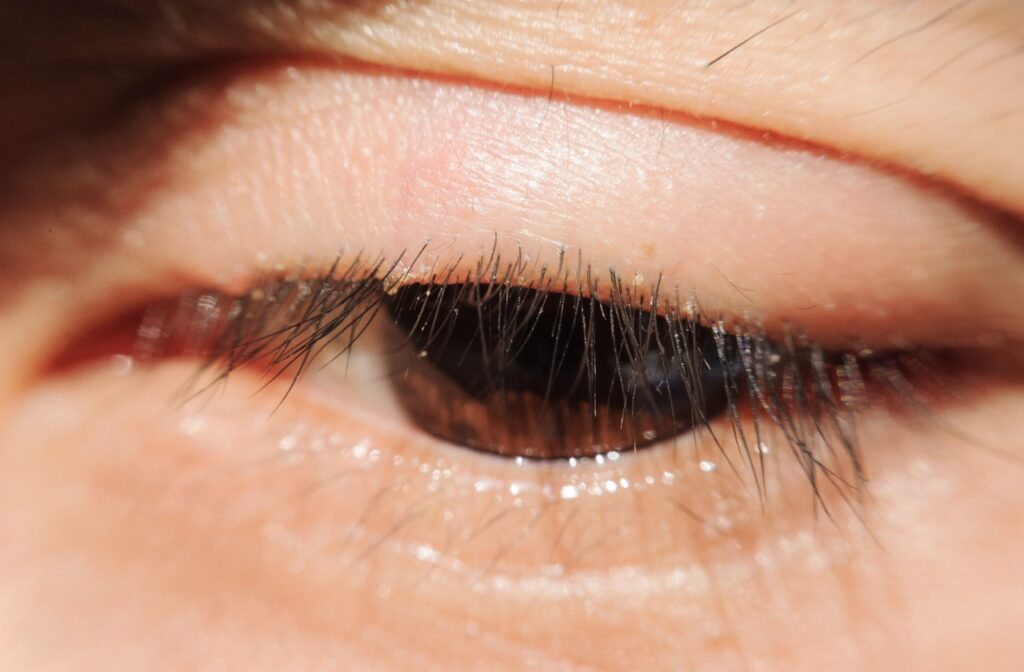Blepharitis is much more common than most people think. However, this eye condition is also often misunderstood. It’s an inflammation of the eyelids that leaves your eyes feeling irritated and uncomfortable, and it has plenty of common causes. While it’s not a medical emergency, blepharitis can be extremely frustrating.
However, there is good news. Blepharitis is not contagious, so you can’t catch it from—or spread it to—someone else. It’s caused by internal factors, such as skin conditions and clogged oil glands, rather than infections.
What Is Blepharitis
Blepharitis affects the eyelids—often where the eyelashes meet the skin. It leads to redness, swelling, and a gritty feeling in the eyes. Many people find that their symptoms are worse in the morning, but flare-ups can happen at any time.
Although it’s not contagious, blepharitis requires consistent care and attention. Managing the condition starts with understanding its underlying causes and symptoms, so you can begin to take steps toward relief. That’s why staying informed and proactive is so important.
The Different Types Of Blepharitis
Blepharitis is categorized into 2 main types:
- Anterior blepharitis occurs on the outer edges of the eyelid, near the base of your eyelashes. Bacteria or dandruff is usually the cause, but sometimes tiny mites or allergies play a role in irritation and discomfort.
- Posterior blepharitis develops on the inner eyelid. It happens when the oil glands, which produce oil to protect your eyes, become clogged. Skin conditions like rosacea or dandruff are common triggers.
Some people may experience only one type of blepharitis, while others might have both at the same time.
What Causes Blepharitis
Blepharitis typically stems from a combination of factors. Your eyes are complex, and they’re vulnerable to plenty of underlying causes that irritate and inflame the eye.
Some common causes of blepharitis include:
- Bacterial infections
- Blocked oil glands
- Skin conditions like dandruff or rosacea
- Allergic reactions, including eye makeup or contact lenses
- Poor eyelid hygiene
- Mite infestations on the eyelashes
The condition isn’t contagious, and it has nothing to do with how you interact with others. Instead, it’s a result of your body responding to internal irritants.
Blepharitis: The Signs & Symptoms
Blepharitis can present with a range of symptoms. These often vary from person to person. Here are some of the most common ones:
- Your eyelids might become red, swollen, or itchy.
- You may notice a burning sensation or crust forming near the base of your lashes.
- A gritty feeling could make it seem like something’s stuck in your eye.
- Light sensitivity or excessive tearing may occur at certain times.
If you notice these symptoms, it’s time to talk to your optometrist. They can help you begin managing your blepharitis and treat the underlying cause of your symptoms.
Tips For Treating Blepharitis
Treating blepharitis involves maintaining a consistent care routine. Hygiene makes all the difference—it prevents the buildup of mites, skin, dandruff, and other problems.

Start with the basics:
- Clean your eyelids daily using a warm compress and a gentle cleanser specifically designed for the eyelid area.
- Use a cotton swab to gently remove any crusts or debris from the base of your eyelashes.
- Avoid using eye makeup, as it can worsen irritation or block important oil glands.
- Follow your optometrist’s recommendations for any prescribed treatments, such as ointments or eye drops.
- Stay hydrated and maintain a balanced diet to support overall eye health.
If you ever notice significant irritation, even with a proper hygiene routine, visit your optometrist. We can recommend various in-office treatments and give you hygiene kits to keep your eyes in excellent shape.
Steps To Prevent Blepharitis
Prevention goes hand-in-hand with treatment. It’s often easier to prevent conditions like blepharitis than treat them, so try to:
- Clean your eyelids daily using appropriate cleansers.
- Apply warm compresses to keep your oil glands functioning well.
- Manage skin problems like dandruff or rosacea with suitable products.
- Avoid irritants like smoke, allergens, and harsh makeup products.
- If you wear contact lenses, follow strict hygiene practices and limit your wear time.
Together, these steps can help minimize symptoms and keep your eyelids healthy.
Find The Relief You Deserve
Living with blepharitis can feel frustrating, but relief is within reach. With a little effort and the right care routine, you can lessen flare-ups and keep your symptoms under control. Don’t worry—our team at Dr. Jennifer L. Shane & Associates is here to help.
If you’re dealing with any unusual eye problem like blepharitis, we’re ready to step in and help you find the relief you deserve. Contact us today to schedule an appointment, and take your first step toward finding relief!



